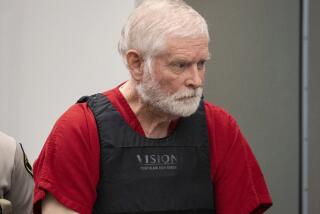A Border Patrol agent shot a drug-running suspect, but the agency won’t reveal much more

A Border Patrol agent shot a man suspected of running drugs during a struggle at this site in Apache, Ariz. The Border Patrol has not released the name of the suspect or the agent involved in the shooting.
The one-story ranch house looks lonely, even from the highway, slouched on a dust-blown ridge 30 miles from the Mexican border.
Here lived the Beans, according to a nameplate long since abandoned. Now, according to locals, it serves as a convenient way station for migrants and drug cartel lookouts along the Mexican border.
So when Border Patrol agents recently found two drug-running suspects in a mud-stuck truck with 2,300 pounds of marijuana near here, it was little surprise that one of the suspects made a run for the house on the ridge.
What happened next goes to the heart of a long-simmering debate among the Border Patrol, police responsibility groups and civil liberties advocates: When the Border Patrol uses lethal force, how much does the agency have to tell the public?
The suspect who ran for the house was cornered by an agent and fought back, according to a statement issued Jan. 25, the day of the incident, by U.S. Customs and Border Protection. The statement also said the man was wounded.
A day later, the agency released another statement. “Preliminary reports indicate that the suspect assaulted the agent during the struggle,” the agency said. “At approximately 10:45 a.m. Mountain Standard Time, the agent fired his service-issued firearm, striking the suspect.”
The statement said that the agent suffered minor injuries and that the suspect was taken by air ambulance to a Tucson hospital, where he was in stable condition. No mention was made of whether the suspect had a weapon.
For two weeks, citing ongoing investigations by the FBI and the Department of Homeland Security, the Border Patrol’s parent agency, Customs and Border Protection, would not say whether the suspect was alive or dead or disclose further details of the shooting. On Wednesday, a CBP spokeswoman said the man shot by the agent was still alive.
The agency hasn’t said where on his body the man was shot, nor the injuries suffered by the agent.
Critics say that unlike most major police forces, the Border Patrol does not move swiftly to announce the names of the agents or suspects involved in shootings. Neither the agent nor the suspect in the Apache shooting has been identified.
Such an approach is at odds with the pledge made last year by Customs and Border Protection Commissioner R. Gil Kerlikowske, who said the Border Patrol would be more transparent, especially when it comes to its use of force.
On Tuesday, a CBP spokeswoman declined to provide details on the Apache shooting and said the agency had turned over the investigation to the FBI. The Justice Department did not respond to questions.
The ultimate goal is to have the case transferred back to the CBP, said Assistant Commissioner Matthew Klein in an interview Tuesday.
As for providing details, such as the name of the agent, “we can’t release information to that level of detail because it’s a criminal investigation handled by the DOJ,” Klein said.
Then, when asked whether his agency had asked the Justice Department for information that could be released, Klein said the CBP had not.
“I can’t say we’ve asked DOJ specifically at this stage,” he said.
The Border Patrol’s most high-profile uses of force usually involve the border itself, especially when agents fire from the U.S. on targets in Mexico.
A review by the Washington-based Police Executive Research Forum analyzed Border Patrol use-of-force policies and focused on cross-border shootings, as well as shootings from police watercraft at people standing in Mexico.
The Border Patrol has pledged to be more transparent, primarily after the review criticized the agency.
In May 2014, Kerlikowske ordered that the Border Patrol’s Use of Force Handbook be made public, along with the research forum’s report.
The Border Patrol also created Use of Force Incident Teams to respond to shooting sites and document evidence. Then, last year, the Department of Homeland Security restored the CBP’s authority to conduct criminal internal affairs investigations.
“This authority will translate to more timely and transparent misconduct investigations,” Kerlikowske testified to Congress in September. He said that allowing the agency to conduct criminal internal affairs investigations would “ensure integrity within the CBP workforce and improve CBP’s responsiveness, transparency and accountability.”
When an agent uses deadly force, CBP has committed to issuing a statement on the incident within an hour after local authorities notify the agency’s Washington headquarters, and a second, more involved statement 12 hours after that.
-------------
For the record
Feb. 11, 5:05 p.m.: An earlier version of this story misstated the CBP’s procedures on issuing statements concerning incidents involving the use of deadly force. It said the agency had pledged to issue a statement on an incident within 12 hours of an incident, and a second, more involved statement within days. In fact, CBP has committed to issuing a statement on a deadly force incident within an hour after local authorities notify the agency’s Washington headquarters, and a second, more involved statement 12 hours after that.
------------
Critics say that most police departments release basic information about incidents in a more timely fashion.
Chris Rickerd of the American Civil Liberties Union’s Washington legislative office said that “any police agency would have to report when and where they used lethal force, and who was involved. I just don’t understand why this agency is exempt.”
When asked how the agency’s silence on the shooting in Apache reflects Kerlikowske’s pledge of transparency, the agency said he would address that question at some point in the future.
For news from the southwest, follow @nigelduara on Twitter.
ALSO
Anaheim police officer fatally shoots man in park
A father, son and lessons from Mt. Baldy’s deadly weekend
Man found shot to death in bullet-riddled car with Uber sticker in Lincoln Heights
More to Read
Start your day right
Sign up for Essential California for news, features and recommendations from the L.A. Times and beyond in your inbox six days a week.
You may occasionally receive promotional content from the Los Angeles Times.







